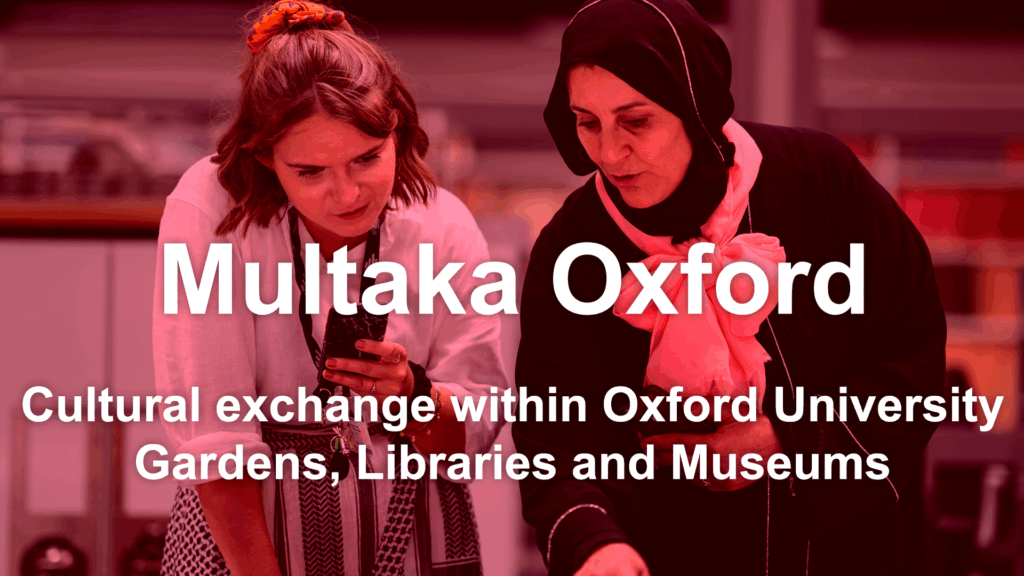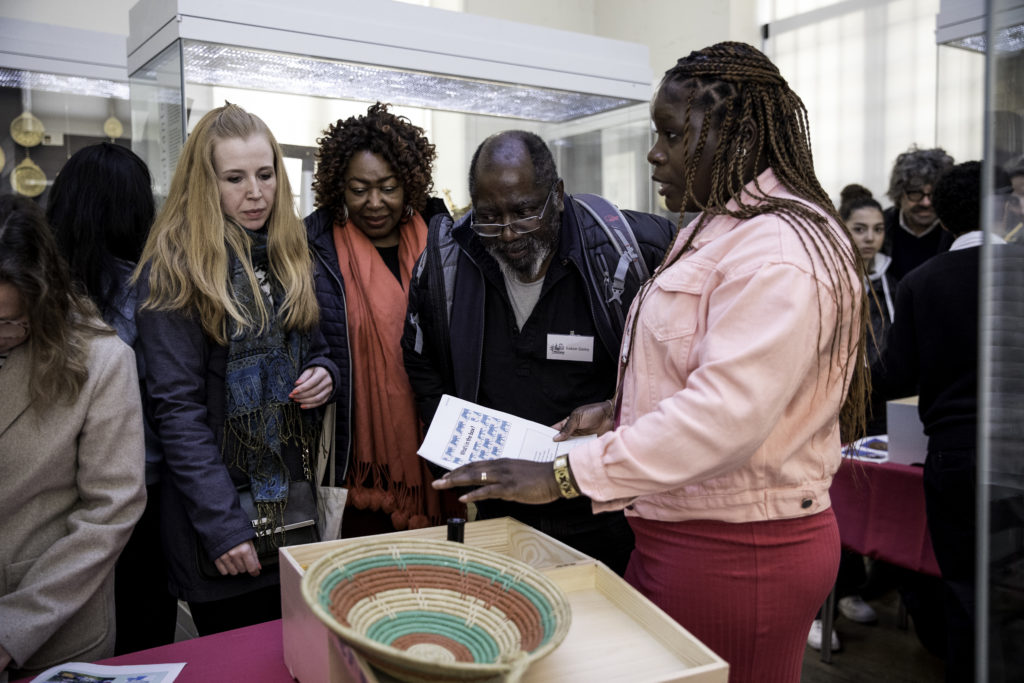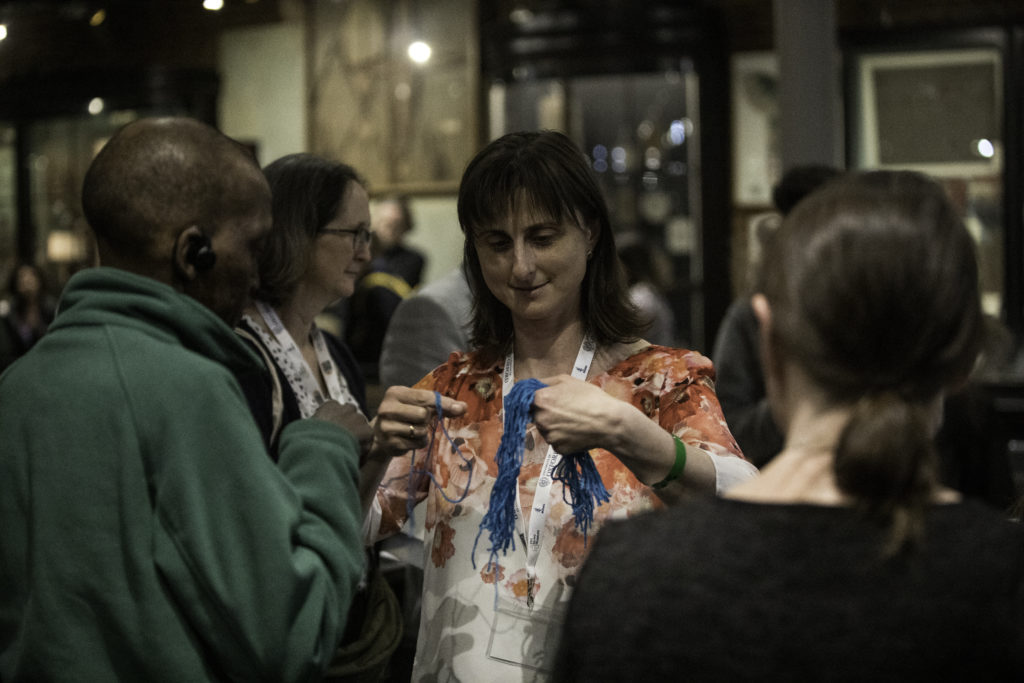
About The History of Science Museum and Pitt Rivers Museum
The History of Science Museum and Pitt Rivers Museum are part of Oxford University Gardens, Libraries and Museums (GLAM) Division. The History of Science Museum is the oldest purpose-built museum that remains open to the public. Its collection focuses on historical scientific instruments, including over 75 astrolabes – the largest collection in the world. The Pitt Rivers Museum is dedicated to ethnography and anthropology, housing a collection of over 500,000 objects, photographs, and manuscripts.
About the project
Multaka Oxford focuses on the social role of museums and their collections to create platforms for intercultural dialogue through the mutual sharing of art, science and culture. The project works collaboratively with people who are settling in Oxfordshire. Its activities generate spaces for belonging and place-making, alongside opportunities for people to share their knowledge and skills within the cultural landscape through museums and within communities.
Project context
The project was originally created by the two museum directors (Silke Ackermann and Laura van Broekhoven) and a community engagement officer (Nicola Bird) working with Oxford communities, including those settling in Oxford through forced displacement. Their goal was to explore different social roles of the two aforementioned museums and to highlight knowledge and experience within local communities, knowing their contributions would bring richer, more accurate, and representative interpretation and ways of engaging with collections. The project was first awarded funding in 2017, to create a place of welcome and skills development for those fleeing the war in Syria.
Originally, the project sought to challenge negative stereotypes around people seeking refuge and asylum and to create connection with cultural heritage. This included engagement with Oxford’s diverse communities to demonstrate migration’s positive societal influence. Within the museum, by taking a person-led collaborative approach, the project was able to highlight the knowledge, skills and experiences a more inclusive approach brought to heritage; to reframe the role of museums; and to approach collection interpretation and museum engagement more inclusively and representatively.
The project has received funding from various sources, including the Esmée Fairbairn Foundation and private donors, and is currently supported by Alwaleed Philanthropies.
Goals
The current goals of the Multaka Oxford project are to:
1. Bring communities together to strengthen understanding and stimulate dialogue through the mutual sharing of art, culture and science.
2. Support and enable volunteers to share and develop skills to enrich their lives and open new opportunities for their futures.
3. Deepen understanding and interpretation of artefacts from the Islamic world and beyond within the heritage sector and our communities, locally and globally.
4. Honour their responsibility as a museum to our communities through engagement and sharing of collections.

Participatory considerations and practices
The project envisions objects and spaces of cultural heritage as playing a significant role of welcome, belonging and identity as people settle into local communities. From the outset, the project team responded to the feedback including from those arriving through the government resettlement programme, Oxford’s diverse communities, community partners and those seeking asylum in the UK. The project embraced a co-creative approach. It looked at who should be paid – creating new roles called Community Connectors – and who would engage as volunteers. It listened to what volunteers needed if they were volunteering to ensure mutual benefit was at the heart of the project so people grew equitably as they developed the project together. The project avoids the initiative being a ‘service’ model and, instead, creates a community that collaborates to co-produce.
Paid team members are responsible for providing structure, safeguarding and processes for the programme within the two museums and within different networks. Paid team members work together when co-planning and co-producing the activities, displays, projects, workshops and presentations. Everyone is encouraged to participate as opposed to a traditional facilitator/participant interaction. To enable this, the project takes an inclusive approach to recruitment to ensure diverse representation, lived experiences and encourages everyone to bring varied perspectives and knowledge into the core planning and creation of the project’s outputs.
The project takes a person-led approach, prioritising people’s experiences and wellbeing. The Multaka team has a social programme that brings people together to connect without expectation of deliverables. This usually happens somewhere like a university college, library, garden or arboretum as the project tries to utilise the university’s spaces and resources. In addition, paid team members will write references for jobs and asylum cases, as well as support with CV and personal statement writing.
Project outcomes
This is a long-term project with many ongoing outcomes but the project team is gathering evidence based on the following:
- Creating change within the institution: The project tries to address the colonial narratives in its museums and aims to make museums more accessible, inclusive, relevant and meaningful. The project demonstrates and evidences change. It creates a place of trust where staff and volunteers explore possibilities. This helps staff and colleagues in the organisation and sector create models on how to work more equitably. It has also shown organisations how it cares and prioritises the wellbeing of staff and team members who are working with people who may have experienced trauma. This is through a programme of supervision for all staff and signposting to counselling services.
- Confidence: confidence is highlighted by volunteers and comes from a programme which is outside volunteers’ accommodation and is part of places of cultural significance. Joining the programme can be the first time people navigate local public transport in the UK, enter these spaces (university and museums), and/or take part in regular activity outside of college/home office visits. Volunteers are encouraged to present their ideas to others, plan and deliver as part of a team and see the outcomes of their ideas, research, designs, and plans. These outcomes are highly valued by the organisation, its staff and members of the public. The bigger picture of their work is consistently communicated and shared.

Reflections
The objects, collections and museum spaces enable inter-cultural exchange through collaboration; smaller volunteer teams move from discussion to activities that can be shared with wider audiences. Multaka team of staff and volunteers have the potential connect with a huge diversity of audiences within the general public. Not only does it collaborate with members in Oxford’s diverse community, but the project also creates changes within the museums’ spaces, structures and teams.
However, one area of development is embedding practices into the ‘core’ working activities of a museum. More co-creative, collaborative and inclusive practice remains the most challenging aspect of the work.
Looking to the future
The project has two years of funding remaining. Over this time, it aims to provide clear pathways into the project for people who are interested and want to access volunteering.
Multaka at the Pitt Rivers Museum is looking into creating ‘meeting points’ in the permanent gallery to provide a clear legacy for the museum sector and demonstrate how enriching knowledge and skills can contribute to historical institutions including the University of Oxford.
At the History of Science Museum, Multaka supports opportunities to explore connections between people, science, art and belief, involving volunteers in its redevelopment plans. The project team are also partnering with departments, colleges and student societies to co-create programmes that promote cultural diplomacy, collectively benefitting volunteers, students and the institutions. The project has outreach groups to enable people to connect with their community and develop methods of belonging to their hometown.
Finally, the project is building on its young people in Cultural Club (ages 16-24) to enable young adults to add their perspectives and experiences into museum venues and the Multaka project. Many are young people seeking asylum or refugees, who value activities during school holidays and weekends which can otherwise feel isolating. As the project develops this strand of work, its goal is to offer these young individuals more significant roles in the museum, seeing them as key contributor and creator in these spaces.
The project will continue to share our work by co-presenting at conferences and co-delivering training with volunteers.
Learn more
https://www.hsm.ox.ac.uk/multaka-oxford
https://www.prm.ox.ac.uk/multaka-oxford